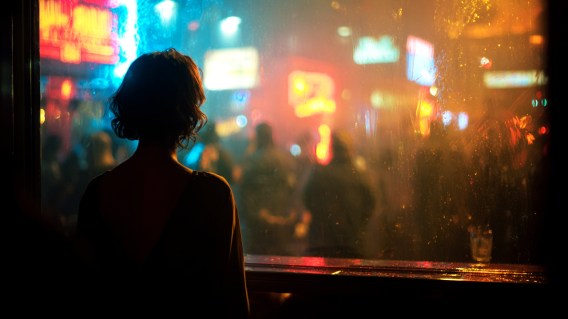‘Alive, connected and unscripted’: Why brands must become the patrons of live experience
Live experiences — the ones that happen as the sun rises, after dark, in real places with real people — restore an energy that digital can’t replicate. In this piece, Mumbrella head of curation Cat McGinn argues that it’s the shared physical spaces where culture happens and community takes shape, and where brands need to be if they want to matter.

'We've conditioned audiences into caution' (Midjourney)
The way we look at the world is, of course, entirely shaped by our own context.
For marketers — and especially those in agencies — this often means holding oddly deep knowledge across a scattershot of verticals: part-time masterminds in dog food, home insurance, and cybersecurity, all at once. Sometimes those strange juxtapositions give rise to remarkable insights.
For me, the work of curating Mumbrella’s AI conference Humain, and researching, writing and thinking obsessively about AI over the past three-plus years, has intersected with developing Unlock, our 24-hour economy event, in a way that feels inevitable. Both explore what happens when technology, creativity and human behaviour collide. One is about our digital lives; the other, our physical ones. Both are about connection.
When I heard Michael Rodrigues, NSW’s 24-Hour economy commissioner, describe the historical context influencing “going-out culture” across Sydney and NSW, I was struck by how some old constraints still echo.
Speaking at an event about events (Events Uncovered) earlier this year, Rodrigues said:
“We shouldn’t be restricted by this “nothing good happens after midnight” thinking that has pervaded the penal colony since 1788. It’s a real thing, by the way — that’s actually the fundamental paradigm problem we have: that going out was a permission, not a right.”
That framing — nightlife as permission, not right – -explains a lot. The legacy of colonial control, compounded by the lockout laws and pandemic lockdowns, continues to shape when, how, and even whether we leave our homes.
Those policies have created a behavioural hangover. We’ve conditioned audiences into caution. People have fallen into a luxury trap — lulled by streaming platforms, delivery apps and the soft embrace of the Ugg boot. A perfectly curated cocoon, warm, safe, endlessly customisable.
On one hand, that’s a marketer’s dream: captive, pathologically online, screen-glued and endlessly measurable. For an industry fixated on performance media, that’s gold. But as AI-generated content multiplies and attention fragments, brands will find it harder than ever to cut through the noise. The more we automate, the less we truly connect. The brands that will win are those that can still make people feel something real.
Live experiences — the ones that happen as the sun rises, after dark, in real places with real people — restore an energy that digital can’t replicate. The night-time economy isn’t just about venue revenue or footfall, it’s about the shared spaces where culture happens and community takes shape. Moments like the resurgence of Tropfest, or hearing Gomeroi artist Kobie Dee explain why he chose to work with Didi, remind me why I do this work. They reignite purpose. They give me life, as the kids say.
What those moments share is a sense of contained risk — the small, electric uncertainty of showing up somewhere new, meeting people you didn’t plan to, discovering something you didn’t expect. That’s not just nostalgia; it’s a rite of passage. Every generation needs its own moments of jeopardy and discovery, the places where you get lost and find yourself again. Without them, culture turns into content. Easy to scroll, impossible to feel.
Because that feeling — of being alive, connected, part of something unscripted — is what we risk losing. If younger audiences grow up largely working from their bedrooms, avoiding real-world dating, and retreating into hermetically sealed digital lives where engagement-optimised AI companions meet their emotional needs, what kind of culture will remain? And what environment do brands have advertise in when culture becomes content, when shared experience becomes isolated consumption?
That’s not a culture brands can survive in. When everyone’s buying the same AI-generated content and the same programmatic inventory, the only differentiation left is making people feel something real. And you can’t do that when your audience has been trained not to show up.
This is where brands must act as the modern-day patrons — underwriting creativity, commissioning collaborations, building the infrastructure where culture can still happen. When done well, this isn’t transactional, it’s survival. The best brands create environments where discovery happens, where people feel safe enough to take a chance, where going out becomes a right again, not a permission.
Mumbrella’s 24-hour economy event Unlock takes place on October 30. A few tickets remain.

